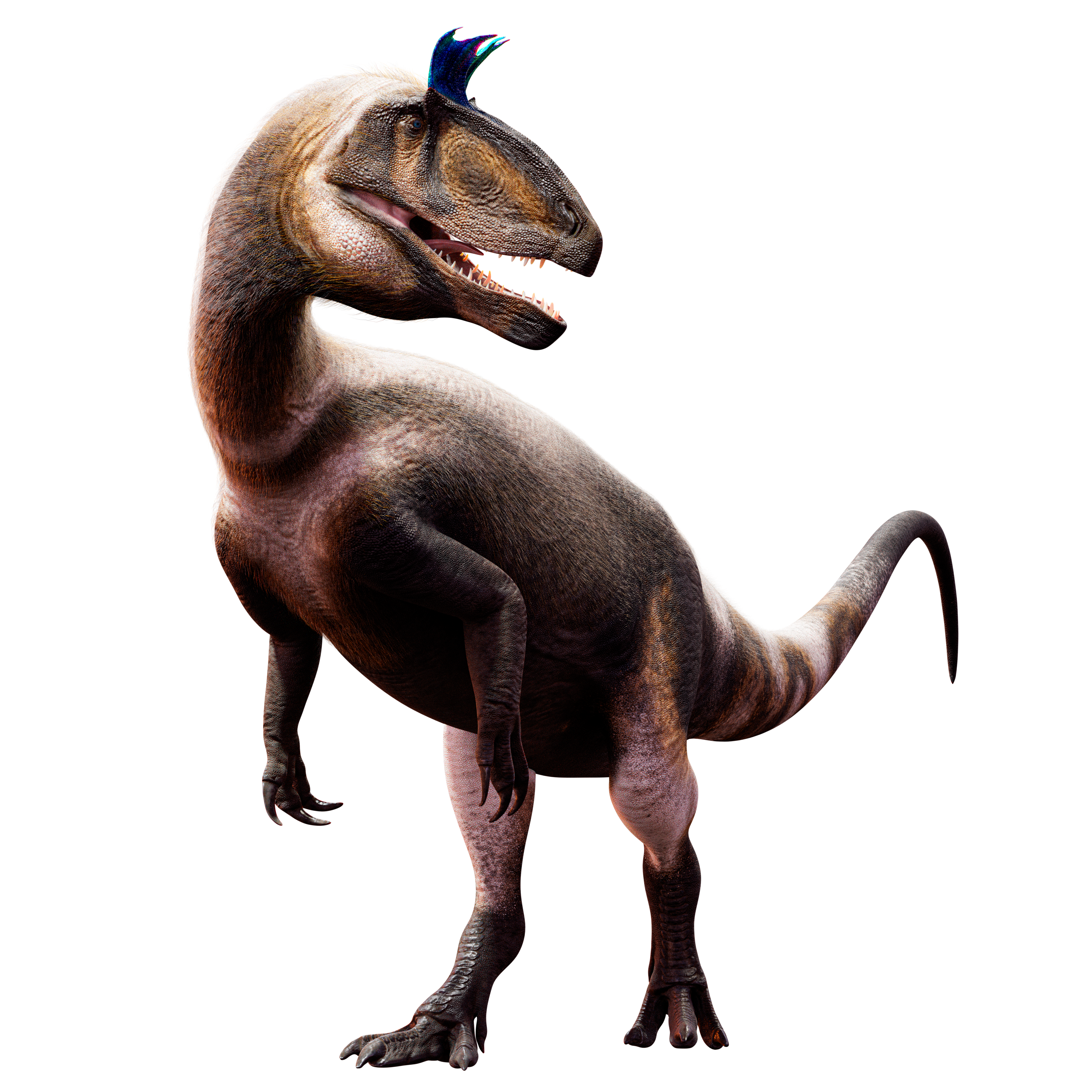The Cold-Crested King of Jurassic Antarctica
Where now is locked in ice and cold was once the domain of Cryolophosaurus, one of the first truly large predatory theropods of the Early Jurassic. It's crown was a unique crest above its eyes which some have compared to the hair style of rock and roll "king" Elvis Presley!
Overview: The Early Jurassic saw the dinosaurs truly take over the world, and the first truly large dinosaurian apex predators rise to power. One of these was Cryolophosaurus a large, crested, carnivore, outwardly similar to the American Dilophosaurus, discovered in Antarctica in the early 1990s. Ruling over a much warmer and lusher Antarctica than the frozen continent we know in the modern age, Cryolophosaurs serves to inform our knowledge about Early Jurassic Antarctica, as well as the early evolution and diversification of theropods. Its strange crest, unlike that of any other known dinosaur, also serves to show just how strange and unique life on our planet can be.
Discovery and Naming: Cryolophosaurus was discovered on Mount Kirkpatrick in the Central Transantarctic Mountains of Antartica, some 4,100 m (13,500 ft) above sea level. It was preserved in the Early Jurassic rocks of the Hanson Formation, dating to between 186 and 182 million years ago. Its discoverers were a field team from Augustana College, led by William R. Hammer. It was painstakingly excavated from the harsh and unforgiving Antarctic landscape between 1990 and 1991, after which the remains, which included very incomplete material from two individuals, were sent to the Field Museum of Natural History in Chicago. Its remains were found alongside the remains of the sauropodomorph Glacialisaurus. Together they are tied for the title of second dinosaur discovered from Antarctica. The first was the Cretaceous ankylosaur Anarctopelta. However, Cryolophosaurus was named in 1994, before either Antarctopelta or Glacialisaurus, making it the first dinosaur named from Antarctica. Its name comes from the Greek words kryos (cold), lophos (crest), and sauros (lizard), meaning “Cold Crested Lizard” in reference to its cold location in Antarctica and its unique display crest.
Evolution: Cryolophosaurus was a theropod often thought to be a close relative of Dilophosaurus, which was of a similar size and also bore prominent crests. However, its exact evolutionary relationships, including whether or not it is a close relative of Dilophosaurus, is debated. Some have placed it as more derived (“advanced”) than Dilophosaurus and Ceratosauria and a close relative of the megalosaurs. However, most recently it has been recovered as a basal (“primitive”) neotheropod, along with the slightly more derived Dilophosaurus. Neotheropoda is the group which includes coelophysoids and all more derived theropods, or in other words, all theropods except for the herrerasaurs and other early genera like Eodromaeus and Tawa. Or in oversimplified terms, all theropods that are indisputably true theropods. Cryolophosaurus is currently recognized as more derived than either Coelophysoids or Zupaysaurus, but less derived than either Dilophosaurus or the ancestors of ceratosaurs and tetanurans (theropods with stiffened tails and three or fewer fingers, including everything from Megalosaurus, to Allosaurus, to T-rex, to Velociraptor, to birds). This means that Cryolophosaurus probably shared a near common ancestor with Dilophosaurus, which itself probably evolved from somewhat coelophysoid-like ancestors. Cryolophosaurus was part of the first wave of truly large (over 6 m/20 ft) theropods to evolve.
Description: Cryolophosaurus was a rather large animal, measuring about 6–7.7 m (20–25.3 ft) long and weighed between 350–780 kg kg (772–1,720 lb), making it one of the largest theropods of the early Jurassic. It had a fairly basic theropod body plan. It was more lightly built than later theropods like megalosaurs and allosaurs, but it more robust than the coelophysoids. Its skull in particular was fairly deep and robust, resembling later theropods more than the similar-sized Dilophosaurus, which had a more gracile skull. Its jaws were lined with sharp serrated teeth, and above its eyes was a peculiar crest which was fan shaped and bent forward, giving it a sort of “pompadour” appearance, often compared to rockstar Elvis Prestley. This crest was used for display, perhaps for intraspecies recognition, or perhaps for attracting mates and/or intimidating rivals. Like other early theropods, Cryolophosaurus had four clawed fingers on its hands. Many later theropods had only three or fewer fingers.
Ecology: 186 million years ago, the Earth’s climate was much warmer than in is now, including at the poles, meaning Antarctica had no permanent ice caps. Additionally, the region where Cryolophosaurus lived was at that time some 1,000 km (621 mi) farther north than it is today. Thus, while other parts of Antarctica would have been colder, the region in which Cryolophosaurus lived was decently warm (though still cool by global standards), and fully foliated by plants which included ferns, horsetails, and conifers. In both climate and in many aspects of flora, the habitat of Cryolophosaurus probably resembled the open woodlands of modern-day North Island, New Zealand.
Cryolophosaurus was the apex predator in its environment. It lived alongside rat-sized relatives of mammals called tritylodonts, and at least one type of small pterosaur, a relative of the European Dimorphodon, as well as two smaller unnamed theropods. Its prey would have likely been the sauropodomorphs, including two unnamed species, and the largest animal in Early Jurassic Antarctica, Glacialisaurus, an herbivore which was only slightly longer than Cryolophosaurus but which weighed 3.6-5.4 tonnes (4-6 tons). Due to Glacialisaurus’s weight advantage and its defensive thumb spikes, Cryolophosaurus may have preferred to hunt juvenile and sick Glacialisaurus in order to avoid injury from the healthy adults. Stomach contents of Cryolophosaurs included a tritylodont, indicating that these small animals also at least occasionally made up part of its diet.
Cryolophosaurus ruled over a geologically active environment with frequent volcanic activity caused by the breakup of Pangea. Frequent ash falls probably meant rich volcanic soil, great for plant growth, but it also meant that animals like Cryolophosaurus had to be adapted to deal with occasional serious environmental disturbances when large eruptions happened.
Extinction and Legacy: Due to our severely incomplete knowledge of the fossil record of Antarctica, it is unknown why Cryolophosaurus went extinct. However, the Early and Middle Jurassic was a time of great change which saw dinosaurs begin to truly dominate the world for the first time in their history. It is easy to infer that as dinosaurs spread and took firm control of the world in the Jurassic, Cryolophosaurus was simply replaced by more derived forms of theropods, like the ceratosaurs, megalosaurs, and allosauroids. Today, the bones of Cryolophosaurus reside at the Field Museum of Natural History in Chicago, IL, USA. Replicas can be found elsewhere, including Augustana College, IL, USA, and the Australian Museum in Sydney, Australia. A travelling exhibit called Antarctic Dinosaurs was developed by the Field Museum, Chicago in partnership with the Natural History Museum of Los Angeles County, Discovery Place – Charlotte, NC, and the Natural History Museum of Utah, and includes both a full skeletal reconstruction and a fleshed out life reconstruction of Cryolophosaurus. Check to see if it is coming to a museum near you!
Cryolophosaurus FAQ
Cryolophosaurus size / How big was Cryolophosaurus?
See height, weight, and length.
Cryolophosaurus height / How tall was Cryolophosaurus?
Cryolophosaurus was around 2.5 meters (8.2 ft) tall.
Cryolophosaurus weight / How much did a Cryolophosaurus weigh?
Cryolophosaurus probably weighed about 350–465 kg (772–1,025 lb).
How long was Cryolophosaurus?
Cryolophosaurus grew 6–7.7 m (20–25.3 ft) in length.
What did Cryolophosaurus eat?
Cryolophosaurus ate meat, probably other dinosaurs, and perhaps including Glacialisaurus.
What is Cryolophosaurus’s closest living relative?
Like all dinosaurs, the closest relatives of Cryolophosaurus are the only surviving lineage of dinosaurs today, the birds. Crocodilians, while not dinosaurs themselves, are also more distant cousins of dinosaurs.
Cryolophosaurus family members / Cryolophosaurus family / What kind of dinosaur was Cryolophosaurus?
Cryolophosaurus was an early theropod (two-legged, mainly carnivorous dinosaurs) in the clade Neotheropoda, and it may have been a relative of Dilophosaurus.
Where did Cryolophosaurus live? / Where was Cryolophosaurus found?
Cryolophosaurus lived in Antarctica and is the second dinosaur discovered on the continent.
When did Cryolophosaurus live?
Cryolophosaurus lived about 186-182 million years ago during the Early Jurassic Period.
What does Cryolophosaurus mean? / Cryolophosaurus name meaning
Cryolophosaurus means “Cold Crested Lizard” because of the crests over its eyes and the fact that it was found in Antarctica.

